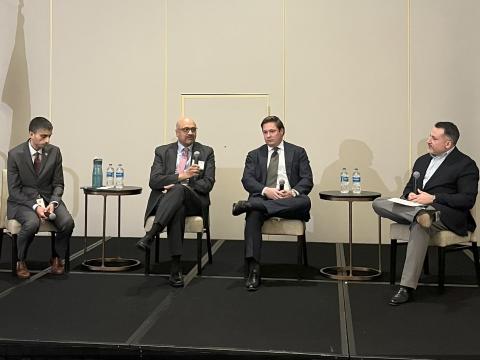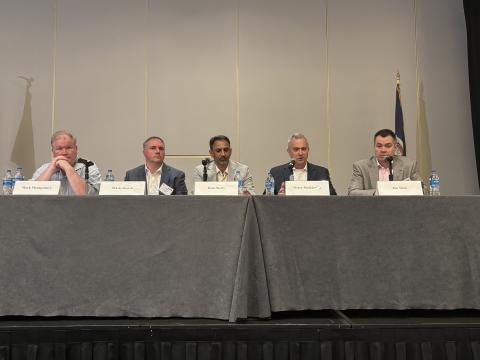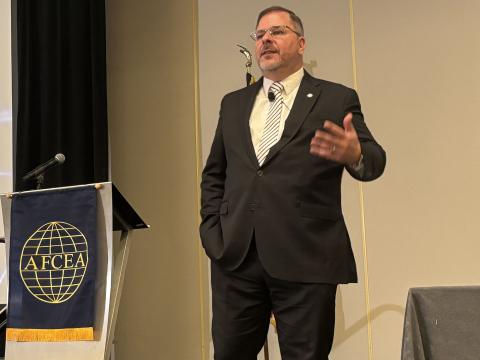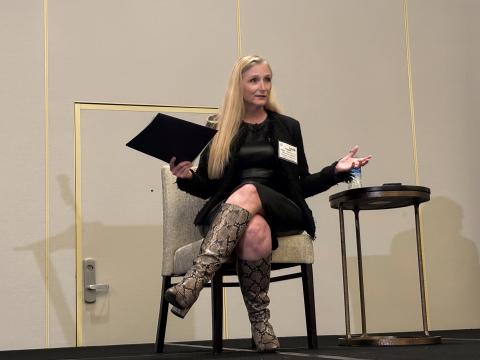Flexible Circuits Unfold
Warfighters one day may have electronics literally painted onto their uniforms thanks to a new technology for printing circuitry. The process involves spraying a film composed of carbon nanotubes onto a surface to form thin, flexible circuits. This capability opens the possibility for communications devices to be built into clothing or solar panels sprayed onto the tops of tents.
Funded by the U.S. Air Force Office of Scientific Research (AFOSR), the flexible electronics project is a partnership between researchers at DuPont and Cornell University. The scientists have discovered a way to produce a semiconducting ink that can be sprayed to form thin, flexible electronics. This solution-based process would allow electronics manufacturers to access markets such as clothing and medical implants that currently are beyond the realm of traditional semiconductors, says George Maliaras, director of the Cornell University Nanoscale Science and Technology Facility. Maliaras is a participating researcher in the AFOSR program.
Carbon nanotubes are the key feature of this ink. Composed of a single carbon molecule formed into a tube, these structures have been studied for years because their tiny size and ability to efficiently move electric currents make them very useful in microelectronics.
But a fundamental hurdle faced by electronics designers is that when nanotubes are made, or synthesized, an undifferentiated mix of metallic and semiconducting tubes is produced. Currently, this unfiltered mix of nanotubes can be used in electrodes and connections, but not in circuits. The main development challenge has been in removing or separating the metallic nanotubes from the semiconductor tubes. The AFOSR researchers discovered a method to chemically change the metallic nanotubes so that they would not interfere electrically with the semiconductor tubes. Known as cycloaddition, the process attaches fluorinated molecules to the nanotubes that eliminates the short-circuiting properties of the metallic tubes.
However, Maliaras contends that scientists do not really understand if the process either eliminates the metallic tubes or converts them to semiconductors. But he notes that the result of cycloaddition is that the metallic tubes no longer interfere with the existing semiconductor tubes.
Maliaras explains that the process now allows nanotube-based solutions to be inexpensively created and spread across very large surfaces, beyond the realm of what currently is available. For example, researchers may soon develop semiconducting inks that can be sprayed on surfaces such as cloth.
The next part of the program will determine if the process can be used to control the doping of the nanotubes. Because nanotubes are still a relatively new technology, Maliaras explains that much of the current research has focused on processes for efficiently growing the structures for use on microchips and in electronic components such as integrated circuits.
For the laboratory bench-top work, the nanotube film was laid down on a heavily doped silicon oxide base. Maliaras says that this base provides a stable, insulated base on which to conduct tests. But materials such as cloth must be able to interact with the printed circuitry. He notes that for every new material that may serve as a substrate for the spray-on circuitry, a great deal of research must be conducted to fully understand that material’s properties.
The four-year flexible electronics project is now in its second year. Over the next two years, the research team will focus on two areas. The first is to understand what happens during the conversion of the metallic nanotubes, and whether it is possible to use this understanding to control the doping process. The second area is to explore the technology’s application in solar cells.
Read an expanded version of this article in the June 2009 issue of SIGNAL Magazine, in the mail to AFCEA members and subscribers June 1, 2009. For more information about purchasing this issue, joining AFCEA or subscribing to SIGNAL, contact AFCEA Member Services.




Comments